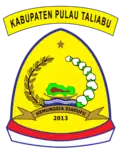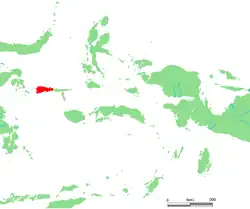Taliabu Island Regency
Taliabu Island Regency (Indonesian: Kabupaten Pulau Taliabu) is a regency in the North Maluku province of Indonesia, mainly consisting of the island of Taliabu, the most western geographically of the Sula Islands archipelago. It was formerly part of the Sula Islands Regency, but on 14 December 2012 it was administratively separated to form a separate regency. It is located to the west of Mangole Island and Sanana Island, the two islands which remain part of the Sula Islands Regency. Taliabu Island Regency (including minor offshore islands, predominantly to the west and southwest of Taliabu itself) covers 2,985.75 km2; it had a population of 47,309 at the 2010 Census[2] and 58,047 at the 2020 Census;[3] the official estimate as at mid 2022 was 63,231.[1]
Taliabu Island Regency
Kabupaten Pulau Taliabu | |
|---|---|
 Students seen playing volleyball at the local school | |
 Coat of arms | |
| Motto(s): Hemungsia Siadufu (Together and United) | |
 Location within Maluku Islands | |
| Coordinates: 1.8°S 124.8°E | |
| Country | |
| Province | |
| Capital | Bobong |
| Government | |
| • Regent | Aliong Mus |
| • Vice Regent | Ramli |
| Area | |
| • Total | 1,152.80 sq mi (2,985.75 km2) |
| Population (mid 2022 estimate) | |
| • Total | 63,231 |
| • Density | 55/sq mi (21/km2) |
| [1] | |
| Time zone | UTC+9 (IEST) |
| Area code | (+62) 921 |
| Website | taliabukab |
History
The establishment of the Taliabu Island Regency was intended to encourage the improvement of services in the fields of government, development and society, as well as the ability to utilize regional potentials for the implementation of regional autonomy, so it was necessary to enact a Law on the Establishment of Taliabu Island Regency within North Maluku Province.
The legal basis of this law is Undang-Undang Dasar Negara Republik Indonesia Tahun 1945 Article 18, Article 18A, Article 18B, Article 20 and Article 21; Law Number 46 of 1999; Law Number 1 Year 2003; Law Number 32 of 2004; Law Number 33 of 2004; Law Number 27 Year 2009; Law Number 12 of 2011; Law Number 15 of 2011; and Law Number 8 of 2012.
This Law regulated the establishment of the Taliabu Island Regency consisting of 7 (seven) administrative districts (kecamatan) formerly part of the Sula Islands Regency (with one district being divided to create an eighth district), and includes 71 (seventy-one) villages (desa).
Ethnicity
The indigenous population living on Taliabu Island consists of the Mange, Kadai, Siboyo and Panto tribal groups which are classified based on the language used, settled area, and livelihood orientation, etc.[4] Meanwhile, immigrants from outside the island of Taliabu also inhabit the island, namely the Butonese, Ambonese, Banggai, Bugis-Makassar and Javanese.
Although the people of Taliabu consist of various tribes with different cultural backgrounds, the social life of the community has never experienced social inequality, let alone social conflict. This is protected by the local wisdom of the people of Taliabu Island, known as Mangkalomu or gather together to solve various problems based on Dadi Sia Kito Mangkoyong yang artinya bersatu untuk maju. which means to unite to move forward. This philosophy of peaceful community life has been used as a motto by the Taliabu Island Regency government with the term Hamungsia Sia Tofu which means Together and United.
Religion
Based on data from the Central Statistics Agency Taliabu Island district in 2019 it was noted that the religion adopted by the majority of the people in this region is Islam, followed by 75.16% of the population. Then, some of them embrace religion Christianity with a percentage of 24.84%, where Protestanism is 18.98% and Catholicism is 5.86%. And a small number of people embrace Hinduism or the original belief system of the Taliabu community.
Administration
On 14 December 2012 the seven districts (kecamatan) on Taliabu Island (and its offshore islets) were split off from the Sula Islands Regency to create a separate Taliabu Island Regency (Kabupaten Pulau Taliabu); an eighth district (Tabona) was created at the same time. The districts are tabulated below with their areas and their populations at the 2010 Census[2] and the 2020 Census,[3] together with their official estimates as at mid 2022.[1] The table also includes the locations of the district administrative centres, and the number of villages (all rural desa) in each district. The post code is 97794 for the entire Regency.
| Name of District (kecamatan) | English name | Area in km2 | Pop'n Census 2010 | Pop'n Census 2020 | Pop'n Estimate mid 2022 | Admin centre | No. of villages |
|---|---|---|---|---|---|---|---|
| Taliabu Timur | East Taliabu | 378.09 | 3,542 | 3,192 | 3,529 | Samuya | 4 |
| Taliabu Timur Selatan | Southeast Taliabu | 370.70 | 5,066 | 4,440 | 4,939 | Losseng | 9 |
| Taliabu Selatan | South Taliabu | 414.73 | 8,738 | 7,258 | 7,917 | Pencado | 9 |
| Tabona | 155.38 | (a) | 3,245 | 3,526 | Tabona | 7 | |
| Taliabu Utara | North Taliabu | 810.93 | 10,880 | 13,194 | 14,466 | Gela | 19 |
| Taliabu Barat (b) | Southwest Taliabu | 517.79 | 9,027 | 14,196 | 15,634 | Bobong | 13 |
| Taliabu Barat Laut (c) | Middle West Taliabu | 189.19 | 4,079 | 4,813 | 5,095 | Nggele | 5 |
| Lede (c) | Northwest Taliabu | 148.94 | 5,977 | 7,709 | 8,125 | Lede | 5 |
| Taliabu Island Regency | 2,985.75 | 47,309 | 58,047 | 63,231 | Bobong | 71 |
Note: (a) the 2010 population of the new Tabona District is included in the figure for Taliabu Timur Selatan District, from which it was cut out in 2012. (b) includes small islands to the southwest of Taliabu, notable Pulau Seho and Pulau Kano. (c) includes small islands to the west of Taliabu.
Climate
Bobong, the seat of the regency has a tropical rainforest climate (Af) with moderate rainfall in September and October and heavy rainfall in the remaining months.
| Climate data for Bobong | |||||||||||||
|---|---|---|---|---|---|---|---|---|---|---|---|---|---|
| Month | Jan | Feb | Mar | Apr | May | Jun | Jul | Aug | Sep | Oct | Nov | Dec | Year |
| Average high °C (°F) | 30.7 (87.3) |
30.6 (87.1) |
30.8 (87.4) |
31.0 (87.8) |
30.6 (87.1) |
30.3 (86.5) |
29.8 (85.6) |
30.2 (86.4) |
31.0 (87.8) |
31.4 (88.5) |
32.1 (89.8) |
31.1 (88.0) |
30.8 (87.4) |
| Daily mean °C (°F) | 26.9 (80.4) |
26.8 (80.2) |
27.0 (80.6) |
27.2 (81.0) |
27.1 (80.8) |
26.9 (80.4) |
26.4 (79.5) |
26.4 (79.5) |
26.8 (80.2) |
26.9 (80.4) |
27.9 (82.2) |
27.2 (81.0) |
27.0 (80.5) |
| Average low °C (°F) | 23.1 (73.6) |
23.1 (73.6) |
23.2 (73.8) |
23.4 (74.1) |
23.6 (74.5) |
23.6 (74.5) |
23.0 (73.4) |
22.6 (72.7) |
22.6 (72.7) |
22.4 (72.3) |
23.7 (74.7) |
23.3 (73.9) |
23.1 (73.7) |
| Average rainfall mm (inches) | 279 (11.0) |
245 (9.6) |
253 (10.0) |
226 (8.9) |
229 (9.0) |
262 (10.3) |
181 (7.1) |
125 (4.9) |
101 (4.0) |
103 (4.1) |
148 (5.8) |
215 (8.5) |
2,367 (93.2) |
| Source: Climate-Data.org[5] | |||||||||||||
References
- Badan Pusat Statistik, Jakarta, 2023, Kabupaten Pulau Taliabu Dalam Angka 2023 (Katalog-BPS 1102001.8208)
- Biro Pusat Statistik, Jakarta, 2011.
- Badan Pusat Statistik, Jakarta, 2021.
- "Orang Asli Taliabu" (PDF).
- "Climate: Bobong". Climate-Data.org. Retrieved 23 November 2020.


